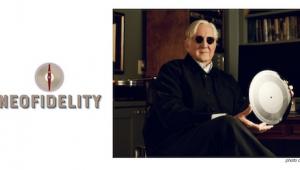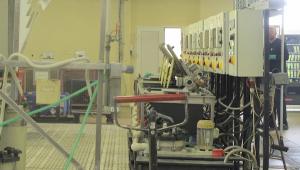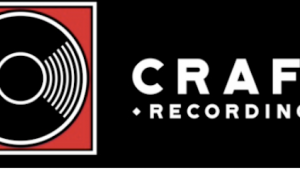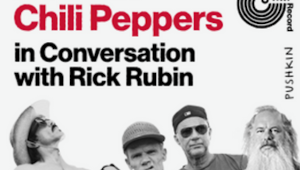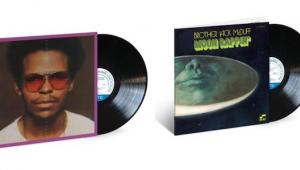His procedure is similar to mine, except that I don't have a steamer (yet). Here's a question that has been nagging at me for some time... When you get a record with the shrink wrap intact (either new, or used with the shrink wrap still intact), is there any reason (other than protection of the cover) to either keep or remove the shrink wrap? Back in the day, I always used to remove it, because someone once told me that it "held in too much moisture", but that just seems like BS to me now. Anyone got an argument either for or against keeping the shrink wrap intact?
Reader Takes Record Cleaning to the Extremes In YouTube Video

The Most Comprehensive Record Cleaning Article Ever!
But more to the point, here's the URL for Crocker's excellent record and jacket cleaning video tutorial:
- Log in or register to post comments


I must admit that I just used a dry cloth to clean my vinyls before I saw this clip. A fellow musician whom I met at the holiday rentals France resort where I went on vacation told me that he had been doing this for years and he perfected his technique over the time. The results are fantastic as that glue gets even the smallest particles off the surface of your vinyls.

Back in the day the word was that leaving tight shrinkwrap on would put uneven pressure on the record, with the potential for warping.

Back in the days, the early 80s, you remove the shrink wrap because it cause more static electricity if you left it on, therefore it would attract more dust. I do not think that is the case now and leave it on if it is still fully intact. Nice to protect the covers.

Prior to watching this video clip I was feeling down and kept saying to myself get a life, after watching the video clip I now know I have a life, boy was I glad I went to the AnalogPlanet website this morning.
James, Dublin, Ireland, where it rains a lot!

Unless an album is a gatefold (in which case it gets a sleeve), I usually leave shrink wrap on as a free protective covers. I have records from the 60s and 70 still in shrink wrap, and call tell you the old wive's tale about shrink wrap "shrinking" and warping the album are BS. It's like those freaks who won't play an album side a second time for HOURS (even heard of 24 hours!) because the heating of the vinyl from the stylus in the groove has not settled down. Come on! When I'm spinning a record at home, sometimes my wife will lift the arm at the end of a side (if I'm busy at the momet), and rather than flipping it over, wil just start the album again. Guess those records are ruined forever!
Cleaning records well...that does make a difference!

...for the "CSI" pseudo music! Seriously, any way you clean records is far better than not cleaning them at all. I cleaned sixteen records this afternoon with my Nitty Gritty 1.5 using a less-involved process (two scrubs with NG fluids, with a different first fluid for the unplayed discs) and I'm perfectly willing to admit that there may be a better way. It still took me over an hour and I took two breaks so it's no one's idea of fun.

That's a great video. Any record cleaned using that method goes from being collectible to a "collecter's item". That being said I get very excellent results running a dirty record under warm tap water and washing with my spin clean using the SC fluid. I allow the records to air dry (sometimes using a hair dryer on low/warm setting) on a dish rack and replace the old inner sleeves with the MOFIs. I get 10 done in an hour.
On the shrink isssue, I leave it on when a promo sticker is present, otherwise I usually remove it. My sense is that any dirt could be trapped under the plastic -- on old records the wrap seems to degrade over time. If the cover is minty, better to keep it clean and happy...
Thank you Mr. Fremer -- Keep sending us this great info!

Wow...thank you for this link...I bought a steamer and added him to my VPI 16.5 -routine...AWESOME!!!!
What a BIG difference it makes...unbelievable...

I really like the heatgun/price tag idea. As for the rest, I don't know if I'll live long enough to complete the procedure; I'm almost 50 as it is.

Not in a million years would I go to these lengths to clean a piece of vinyl. The Disc Doctor two step method is arduous enough but I'm very happy with the results. I think this article should be filed under "I need to get a life"!

I use the Walker Audio Prelude system. Four steps on my VPI 16.5 each side and done. It's the best I have ever used. You will be amazed at albums you've cleaned many times are still dirty. The first step is an enzyme cleaner. Second step is Walker Audio's cleaning solution and the third and fourth steps are lab grade waters. The kit also has four brushes for each step. My last step is to destat with the Mapleshade Ionoclast or their grounded brush. I would never go this messy route that this fellow does! What a pain! The only thing I know that's better than the Walker Audio system is the new cleaning machine that Mr. Fremer is using, but it's almost $4,000.

This is for all who say "it's a myth". My Cheap Trick ep from the eighties did get crushed. I used to leave the wrap on and just cut to let the record out. It's your vinyl. Leave it ( you know who you are) on and see what happens. You must live in a temperature controlled environment.
My vinyl was on a shelf/wall opposite the windows. Yes, this album was on the end of the collection. I immediately removed all wraps. That's why the Japanese make vinyl covers. Use them or not. I value my vinyl. I used to work for a still in business, major retailer in the Audio/Video field.

I just came back to listening to my LP collection and could not justify the big prices for so many of those nice systems. When you have 152 LP's its hard to justify $600 or $900 for those NG machines.
I bought the SpinClean system with some extra drying clothes. It works great. I have done almost half my collection and my time averages 5 to 6 minutes per LP and that includes tossing the old inner liners, adding a new inner liner, and a outter liner. I also roate the LP 4 to 5 times instead of the 3 recommended by the manufacturer.
Interesting video. Lots of work.

If you are not aware of the Mapleshade website, he has been touting steam cleaning for years, and one day when I'm not working 90 hours a week I will add it to my VPI-17F routine using Harry's own concentrate with occasional help from the Record Doctor's concentrate for dirty records and gruv glide. And keep that needle clean!

For a newer record the cleaning process is a bit severe. However, most of my shopping is for records from the late fifties and early sixties. Many of these records are moldy hence the name moldy oldies. Secondly when I moved into vinyl I was doing a comparison against the best digital can offer so I wanted to give vinyl the best chance possible. Since this is a one time cleaning I figured that a couple extra minutes would not break the bank. Of course now that I am up to 800 records that time does add up. Future cleanings and new records would be one shot of VPI cleaner and distilled water. I have had friends who use the spin doctor and sink method bring me their records. After cleaning they report significant reduction in ticks and pops and a better listening experience.
I remove the shrink wrap to get to the mold on the outer cover.

First, thank you for the posting and nice comments. My intention was just to put pictures to the process included in Michael’s very helpful DVD. Plus the videos on YouTube of using wood glue just seemed a bit off.
I thought I should visit YouTube since this was posted and I noticed some questions. So I thought I would post the answers here as well.
1. I only clean new purchases of old records this way. My collection is 18 months old.
2. All my inner sleeves are at a 90 degree angle & the outer sleeve in line with the plastic cover. This way I do not have to remove & possibly damage the outer sleeve when playing.
3. I do not use lighter fluid or Goo Be Gone as they can stain outer sleeves. I also need to use fluids that can rinse off the latex gloves that I wear to keep skin oils off the clean records. Besides, the wife factor generally does not approve of lighter fluid or other flammables. Keep the heat gun 1 inch for 8-10 secs no more.
4. I have cleaned over 800 albums and have had no problems with knife, or 409, & only 1 loose label.
a. I recommend spraying the 409 on the paper towel rather then directly on the cover for sensitive covers.
b. Remember to wipe the label on the record with a paper towel to dry off the moisture.
c. Yes some old 50s labels are not completely color fast.
d. I clean the label because I do not want dirt on my platter.
5. Milty is 4-6" from record, pull slowly, 4X per side recommended but no limit on number of “shots” at the record.
6. I listen to records during dinner and after dinner every night with my wife when I am home and not traveling.
I hope this helps.

I've read that the steam cleaner should be closer to the record, that only the 1st inch or so (the invisible part) is the part that does the steam cleaning. Otherwise you're spraying hot water vapor at the record. Does anyone know about this? I'd be worried about warping, I guess.

The temperature of the shark steamer is less the 90 degrees at 2 inches and low 80s at 4 inches, as measured by a digital thermometer. Since you have cleaning fluid on the record the steamer is used as the rinse to help work the particles loose. Like the misto sprayers both apply a fine mist in order to get into the fine grooves of a record. Technically one could use it to apply cleaning fluid but that would be expensive as a lot of fluid will be lost. Due to the camera angle the steamer angle is closer then it seems. I use it at about 4 inches which seems to be a consensus in the research I did. I have not yet warped a record with the Shark steamer but check the temperature of the steamer, with a theromometer, and use a record you don't care about for your first attempt and that way you wont have to worry.

YouTube has now become a junkyard of waste vedios and picture collections. It’s a good thing that you guys are taking effort to clean up the videos in YouTube to make it user friendly. Keep updating such good information.

Hey. Cable TV subscriptions are completely outdated, as today anyone can subscribe to a streaming video service and watch live TV channels while saving money! Providing an organic combination of live TV broadcasting of quality TV channels and on-demand content, the YouTube TV streaming video service has become the best choice for many. Everyone can read about this streaming service in the youtube tv review and perhaps someone will decide to become one of their many subscribers.




